[Jimbaux will not fade out like a photograph, and neither will Chip, at least not yet.]
Well, I’m glad that, judging by the feedback in the comments section and in e-mails that I received, that many of you are in general agreement with the arguments I made in the previous “Put Your Lights On” post, despite the possible preachy nature of it, but I’m also very glad that that’s done now!
So, Tell Me A Story
For the first time since I caught him at the same location in March, I caught Chip last week at Boeuf. I heard Chip’s voice on the radio, and I figured he was at North Boeuf. So, I stopped there, saw that he was deep in the plant trackage, and parked by the mainline to wait for him. In the meantime, how about this?
Cypress knees, swampy water, and a concrete DOTD marker; ain’t southern Louisiana – particularly the lower Atchafalaya – grand? I generally think so, but in the last week or so, we’ve entered the really hot season, and it’s vexing me more than I thought it would.
Peek-A-Boo
Hey, look at what’s emerging from the foliated spur!
The storyline for all of the remaining pictures in this post is pretty straightforward. All of the remaining pictures except the very last one were taken of this train – or this part of it – simply emerging from the North Boeuf spur and then shoving back to recouple with the remainder of its train on the mainline, and there are plenty of pictures of Chip himself, but for now, we just see Engineer Boudreaux in the below picture, as Chip is riding the rear car so that he can roll the derail.
Yeah, like I said, just a few days before April ended, we entered the season of misery here in southern Louisiana, with the heat and humidity now not all that far from triple digits. I hate it, I tell you; I really do. Were it not for the fact that I’m from here and have many familial and friendly connections around here, I wouldn’t live here. I’d just have to move to Oregon or something, where at least I could still watch the UP operate on former Southern Pacific Railway trackage.
For those of you who have not kept up with the prior Chip coverage here on Jimbaux’s Journal, first, I welcome you to this site, and I hope that our regular readers and commenters welcome you as well. We’re looking at Union Pacific Railroad train LLS51, a.k.a. The Morgan City Local (since it works out of Avondale toward Morgan City), a.k.a. The Chip Local.
Meet Chip
Many readers to this site already met Chip when I introduced them to him back in August at this very same location. Chip is always smiling! He’s a legend in southern Louisiana railroading, having gone to work for the Southern Pacific in 1968! Yes, his railroad career spans 44 years with a break of about 18 months for service in the Vietnam War, and his father was a railroader before him, also for the SP.
I just wish that I had taken the below picture about one second earlier, as that was when Chip noticed me and smiled at me and waved; what you see below is the wave pulling back to him and him looking ahead again.
On Saturday, I had yet another physical setback in a year that has not been good for them. I was on a photo assignment, and it was damned hot. I got off around 11:00, and I was quite useless for the rest of the day, breathing heavily, short of breath. I guess I suffered from heat exhaustion, as it felt like my lungs were at half capacity. This is not good, and for the second consecutive weekend, I got far less accomplished than I had hoped and planned because I was so incapacitated, severely limiting my productivity.
So, I guess I’ll just tell you partly what that sickness was the weekend before, the kind I had never experienced before, the kind that left me in excruciating pain, but first, I need to give some background information, after we see another Chip picture.
For much of the last two years, both my diet and my exercise regimen have greatly suffered, with my diet being probably almost as bad as it had ever been, culminating in the recent Great Plains trip that I took in which I ate plenty of bacon cheeseburgers from Culver’s and Braum’s. Hey, I was traveling!
However, as I had planned all along, as soon as I returned back home, I began a new diet. However, not only did I change what I ate, I also changed how I ate. In the two-and-a-half weeks after I returned from the travels, my diet was as good as or better than it had been at any time in my adulthood! However, the “how” of it is that I began a “graze” diet in which I really didn’t eat meals but, rather, munched on fruits, vegetables, and nuts all day. Aside from having to work a late meeting or attending the Godsmack concert, my fast-food consumption went down to zero, and breakfast (turkey sausage omelette) and occasional chicken were the only time I had grease in my diet. I was never really hungry and never really full – i.e., bloated.
Two-and-a-half weeks into this, on the evening of the last Thursday in April, my digestive tract basically shut down, and I was in excruciating pain, the type of which I had never experienced before. I could not understand why, as I had eaten so healthy for the two-and-a-half weeks preceding this. I could only hypothesize that the influx of good food into my system constituted a shock that the system could not handle. When I finally got to a physician on the following Monday, he said that that’s probably exactly what happened, that he’s seen the problem before. He said I’d have been wiser to ease into the new diet; isn’t that ironic that I’d have been better off eating more cheeseburgers in that time?
Two weeks after the problem started, it seems to have completely gone away, be completely out of my system, and I’m really relieved about that! Now, I’m on to tackling other problems and challenges.
Look at Chip smiling! That man loves his work! He is truly a rich man! The below picture is merely a cropped version of the above picture.
He’s radioing back to Engineer Boudreaux, whom you can barely see in the cab of the locomotive in the back, about shoving back to the rest of the train as he keeps his eye on traffic at the highway crossing.
Below, Chip sees me and says, “how you doin’, James?” (No, he doesn’t call me Jimbaux.)
That was the only talking that we really had a chance to do this time. I couldn’t stick around much longer.
Now you can see the rest of his train, as he has about 10 loaded carbon black hoppers and one empty gondola.
Apparently, there was nothing else running anywhere near here, as Chip had been allowed to leave the rest of his train on the mainline during all that time of switching at North Boeuf.
A New Variation On An Old Theme
There was time and place for one more shot before the sun set. I’ve shot eastbound trains at Horseshoe several times over the last decade, but none of them look quite like this.
Well, that’s a little bit different, and you can see how dark it is by how grainy the image is. Oh, well. I guess all really is well that ends well, right?
Isn’t paying attention to Chip far better than watching that useless television? I think so.
Merci,
Jimbaux

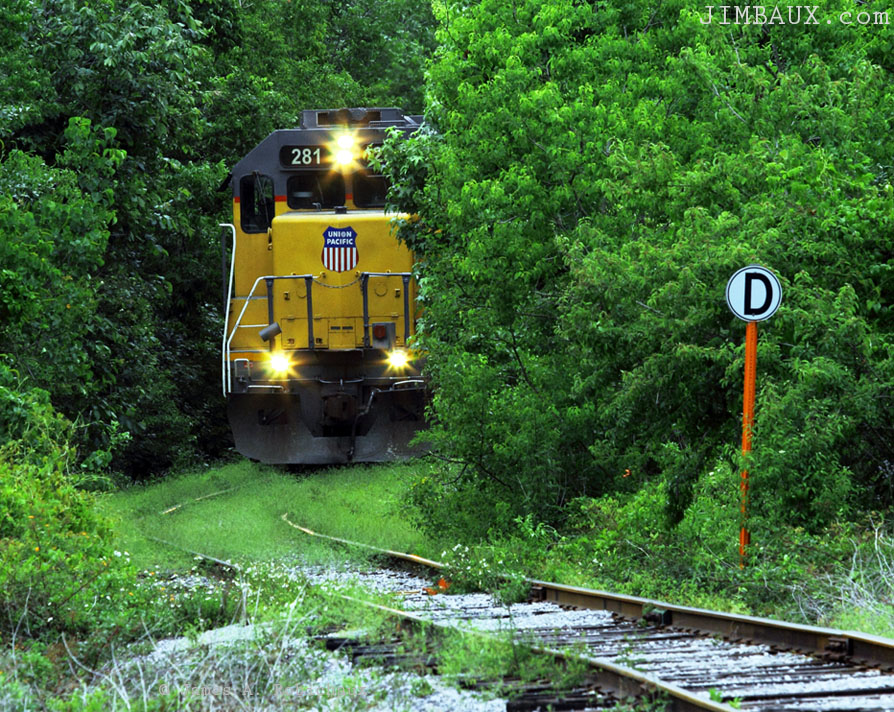

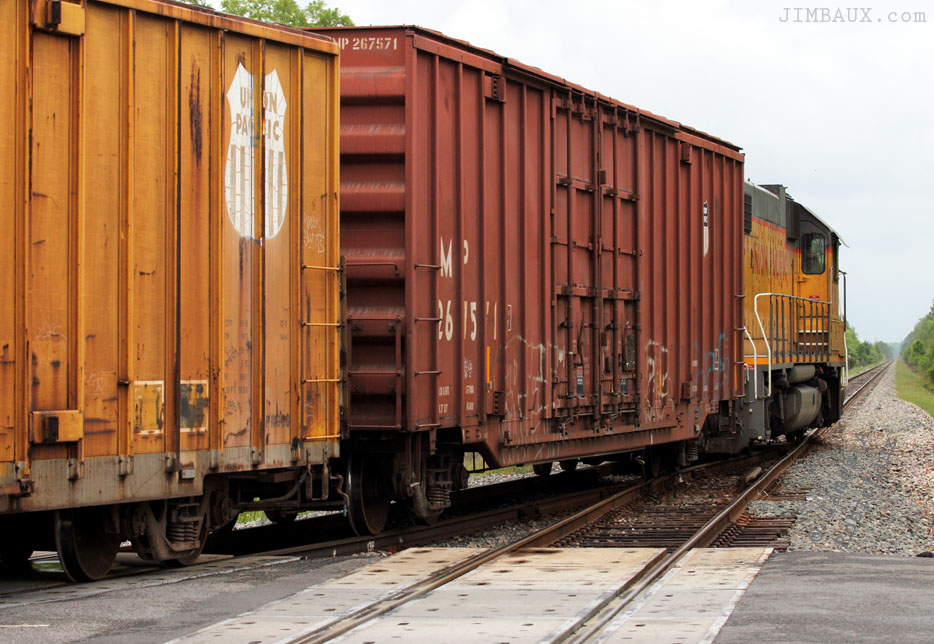
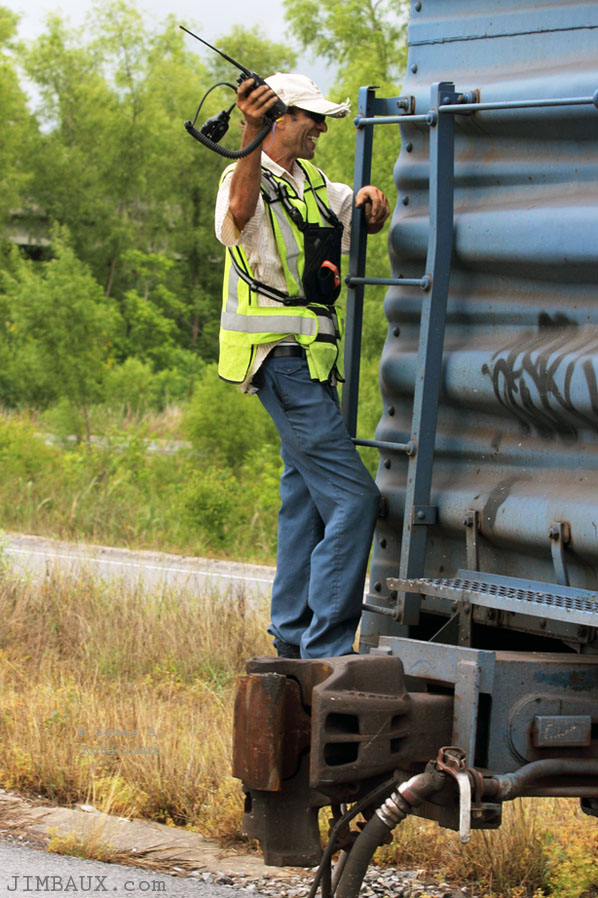
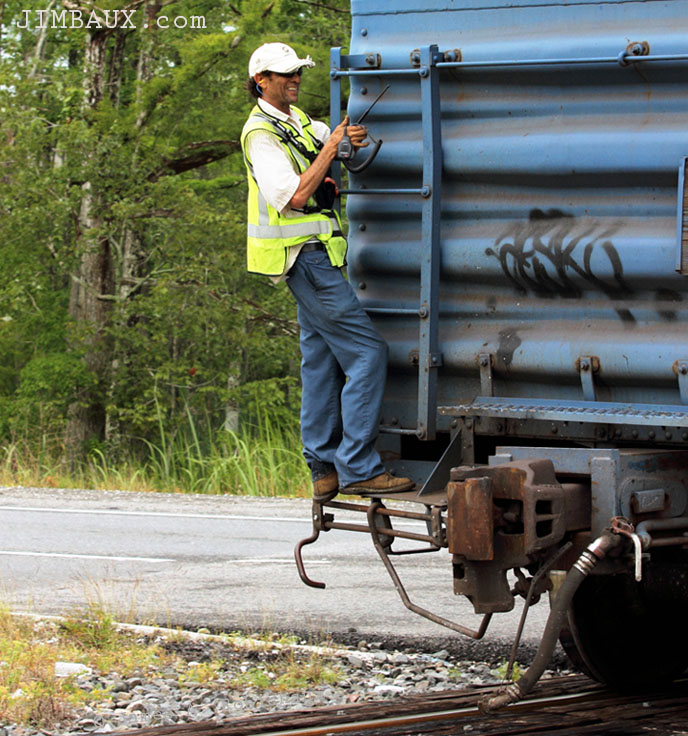

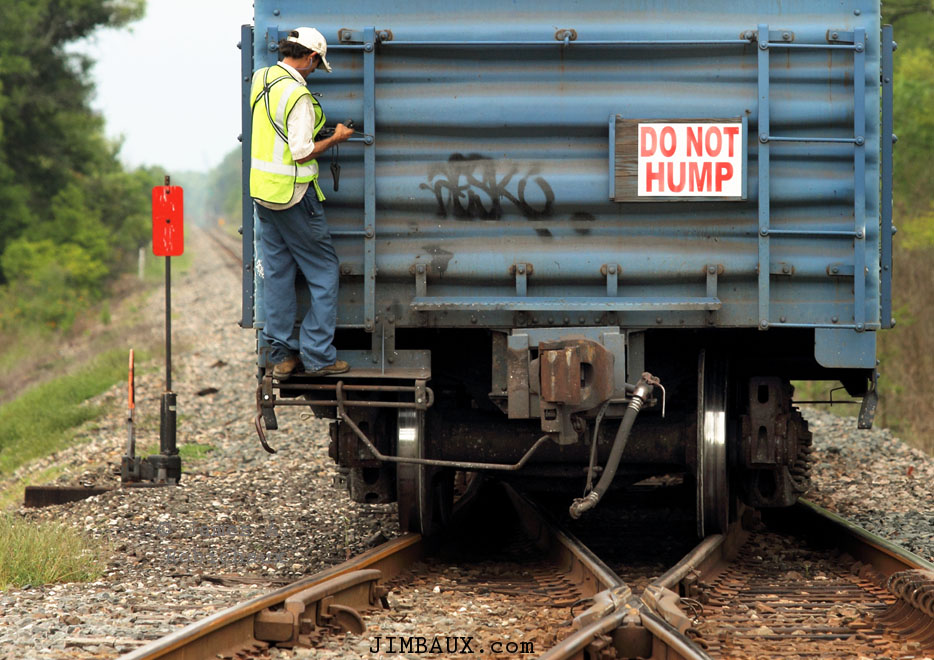




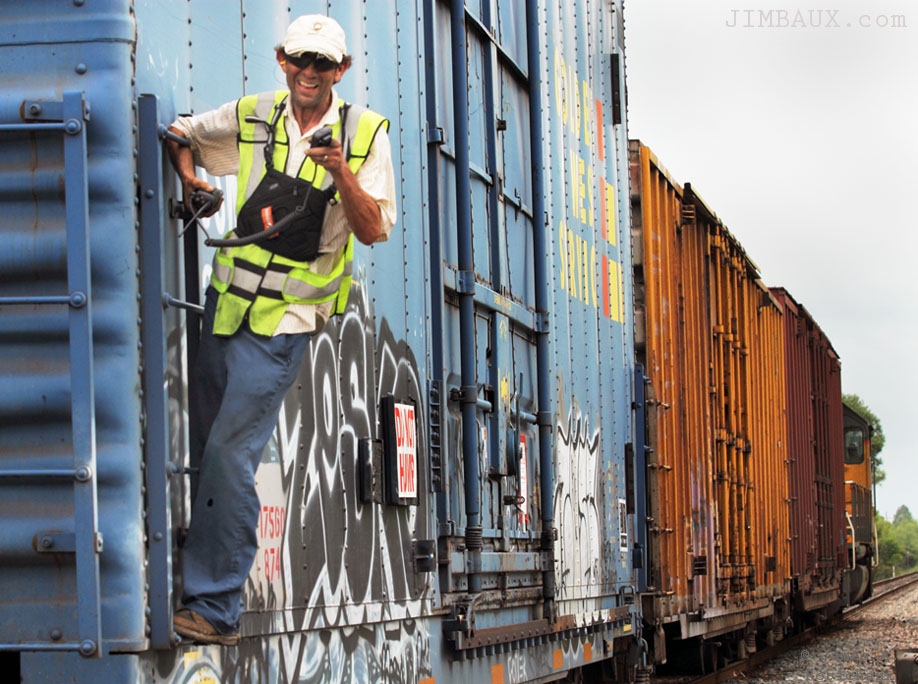

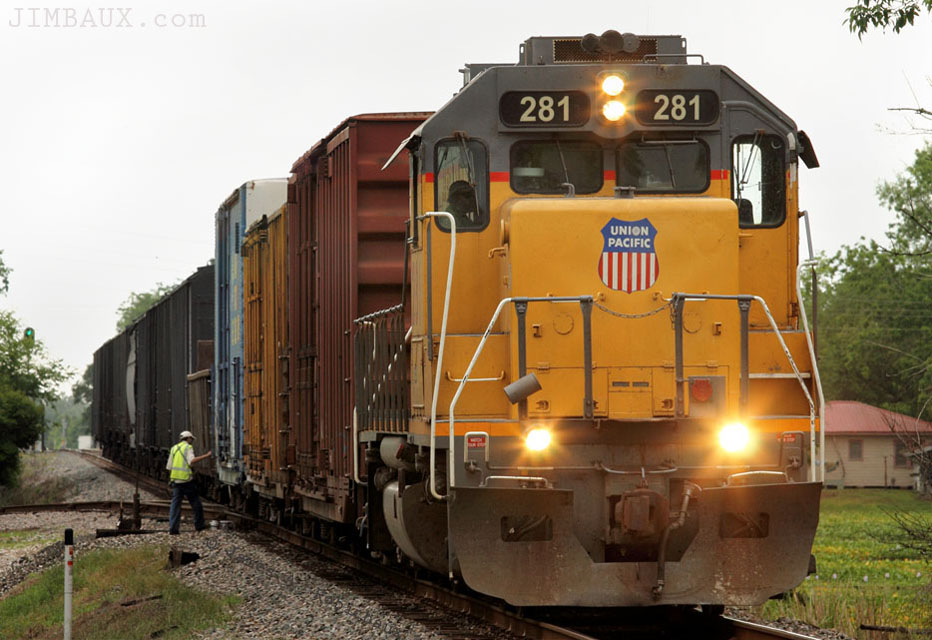


{ 8 comments… read them below or add one }
Jimbaux…another great edition. Love seeing Chip. If you see the RailGoat, say hello for me…and we’ll see the Journal next time….
later
Barry
Can you give me an explanation how the derail works and why it is not at every spur? I love these pics from my own “backyard”.
Love this!! Thanks for bringing it to my attention. Chip seems like a great guy and his smile is radiant. Also glad that you are feeling better 🙂
The Chip pictures are pleasing to many people, and I’m glad that you like them. There are more pictures of him in different posts on this site, starting in August 2011, and the word “Chip” can usually be found in the titles of the posts. Chip would retire last November, and the last time that I photographed him was on his birthday earlier that month:
https://www.facebook.com/photo.php?fbid=452388541485036&set=a.262928767097682.64271.145765538814006&type=3&theater
Well, I was “feeling better” when I made this blog post, but please note that it is more than a year old!
Of course I would not look at the date…duh! I will definitely look at more of your posts. I actually saw a new Louisiana Delta Engine the other day and have a pretty crappy pic since I had somewhere to be and couldn’t stop. Does Union Pacific and Louisiana Delta use the same rails? I have no clue on these things..lol
The short and simple – and too simple – answer to your question is “yes,” but only in specific areas. Like most things in life, though, the answer is not that simple.
The Union Pacific is one of eight major railroads on the continent (seven if you don’t include Ferromex, which operates only in Mexico and is 26% owned by UP.) The Louisiana & Delta Railroad, by contrast, is a “shortline” railroad that provides local service. Very little of the track over which L&D operates is its own. The mainline through our area is owned by the BNSF Railway, which is one of the other “Big 8” or “Big 7” railroads, and it and UP are the only two major railroads in the western United States (not counting Kansas City Southern, which does not go further west in the USA than Fort Worth and Laredo.)
The BNSF mainline through our area is known officially as the Lafayette Subdivision, and the UP has “trackage rights” on the Lafayette Subdivision. “Trackage rights” are rights that one railroad has to use another railroad’s track. The L&D operates as far west as somewhere around Lake Charles (but doesn’t do much work west of Lafayette) and as far east as Salix, which is in the far eastern part of St. Charles Parish; the L&D therefore has “trackage rights” over the BNSF line between those points. When you then consider that Amtrak operates the thrice-weekly Sunset Limited over the Lafayette Sub, you realize that four railroads operate over this line! That is very rare! I think that it makes things interesting here. By contrast, if you go to the Livonia Subdivision line along the river from Avondale through Donaldsonville and Plaquemine, there are plenty of trains there, but they are all for Union Pacific; cross the river and go to Convent or Destrehan, and all of the trains there are for the Canadian National Railroad (like the ones seen in the “river railroading” post on which you commented.)
The Lafayette Subdivision was historically owned and operated by the Southern Pacific Railway. More than a century of consolidation within the railroad industry got us to where we are now, with only seven or eight major railroad companies on the continent; what was considered a “major railroad” 50 years ago would be considered a “regional” railroad today, as mergers have caused the sizes of railroad companies to grow greatly.
The most recent – and, perhaps, final – round of consolidation took place in the mid-to-late-1990s. In the West, the Burlington Northern Railroad bought the Santa Fe Railroad, and the Union Pacific Railroad soon purchased the Southern Pacific, leaving the West with only two giant systems. The BN-ATSF merger (into BNSF) made the UP-SP merger inevitable.
Railroads are heavily regulated (even if not as much as before railroad deregulation in 1980) because of “barriers to entry,” which means that a merger between two companies can greatly reduce competition. So, each merger must be approved by the federal government. UP already owned the Livonia Subdivision and Beaumont Subdivision lines across southern Louisiana to Houston; the Beaumont Subdivision goes from Houston to Livonia via Beaumont and Opelousas, and the Livionia Sub goes from Livonia via Addis and Donaldsonville to Avondale along the river.
Because UP already owned those lines, buying SP would give it the other line across Southern Louisiana and would eliminate competition in that corridor – and, to a much greater extent, the corridor from the West Coast to a connection with the eastern railroads in New Orleans. So, one of the many conditions of regulatory approval for the UP-SP merger in 1996 was that a competing line – the newly formed BNSF – be allowed to operate over that line. This is how BNSF came to control the Lafayette Sub, a line that neither of its predecessor railroads owned. So, today, BNSF owns the line from the Huey P. Long Bridge to Iowa Junction (just east of Lake Charles) with UP having trackage rights over that part of the line, and UP owns the line from Iowa Junction to somewhere in the Houston area with BNSF having trackage rights over that part of the line. This is important not only for local industry but moreso for the big picture of coast-to-coast traffic; the next place north of New Orleans that BNSF connects with the eastern railroads is at Memphis (or Birmingham, but its line to Birmingham comes from Memphis). So, BNSF having access to the New Orleans gateway and the railroads there – specifically CSX and Norfolk Southern – not only serves customers but also puts price and quality pressure on UP in that corridor.
The Louisiana & Delta Railroad was created in 1986 when SP wanted to sell its branchlines in southern Louisiana, which had long been a large trend among major railroads. At that time, as you might remember, two branchlines extended from Schriever: the Napoleonville Branch via Thibodaux to Napolenoville and the Houma Branch. Both of those branches have since been abandoned. The SP also had two branches in St. Mary Parish, the branch from Lafayette to Breaux Bridge, and the Midland Branch from New Iberia to Abbeville. All four of those branches still exist and are still operated by the L&D, even though nearly all of them have been shortened. Also, the L&D later acquired the Lockport Branch, which diverges from the mainline in Raceland, but there has not been a train on that line in more than four years; the closure of Valentine Paper in late 2007 doomed the line just like the closure of Supreme Sugar in 1995 doomed the Napoleonville Branch, though the Lockport Branch still exists whereas the Napoleonville Branch has been removed.
The way that the L&D initially operated was that its trains would be built at the mainline SP stations and then go down the branches to do their work, then return to the mainline stations for SP to pick up the cars. So, L&D would run a train of empty hopper cars to Supreme Sugar, cars that it picked up from SP in Schriever, pull loaded cars out of the refinery, and then bring them to Schriever for the SP to pick up. SP would still serve mainline businesses, like the gas plant in Paradís, as the UP still does today, but it left the branchline stuff to L&D.
Well, to be able to move between its branches, the L&D needed those “trackage rights” over parts of SP’s mainline. At first, one job – one crew – out of Schriever handled both the Houma Branch and the Napoleonville Branch, but by 1991, the Houma Branch was gone. L&D then acquired the Lockport Branch (or acquired a contract to serve it, with SP maintaining ownership), and the one crew in Schriever worked the Napoleonville Branch thrice-weekly and the Lockport Branch on other days; this required the L&D to operate over SP’s mainline between Schriever and Raceland, and similar arrangements exist on other parts of the L&D toward the west. So, today, when you see an L&D train on the mainline, it is using trackage rights over BNSF. So, understand that a shortline railroad like L&D cannot exist without the bigger railroads; none of the traffic that L&D carries both originates and terminates on its rails.
Given all of that, it may be clear by now that any time you see an L&D train, it is basically doing work “for” either UP or BNSF; one of those railroads is going to pick up the shipment somewhere from Salix to Lafayette anyway. So, when L&D goes to pull tank cars loaded with molasses out of Raceland Raw Sugars, most of them are left in Raceland near the mainline for UP to pick up, and the rest are taken to Schriever for the BNSF to pick up.
With so many of the branchlines abandoned are with reduced traffic, and with the big railroads even bigger and more willing to contract out work, L&D’s role has changed since its inception less than 30 years ago. When BNSF took over the Lafayette Subdivision in the mid-late-1990s, it had its own “road switcher” train based in Schriever to serve local industries to the east and west of there: Monsanto and Discovery to the east and Mi-Swaco, Baker-Hughes, and the Port of Morgan City to the west. Due to an insufficient amount of business from those locations, the BNSF Schriever job was abolished in May 2002. The BNSF simply contracted with L&D to do the business, and that is why, even with both branchlines out of Schriever now long gone, there is still plenty of work to keep the L&D Schriever crew busy all week!
So, when you see the L&D go to any of the businesses along the mainline in Boutte, Paradís, Boeuf, or Morgan City, it is doing that strictly for BNSF, as UP serves those places directly (as you can see from the pictures in this post), whereas when you see L&D serving businesses away from the mainline, like Raceland Raw Sugars, MTI Flotek (in Raceland), Valentine Paper (before it closed, of course), the carbon black plants in St. Mary Parish, the sugar mills in Iberia Parish, etc., those cars could be going to either BNSF or UP.
That direct access to two big railroads brings up an unaswerable question. I can only wonder that if the Houma Branch and the Napoleonville Branch could have hung on a little longer if traffic would have picked back up due to having two competing railroads in the area and the inevitable rise in trucking costs. Southern Pacific’s service was “horrible,” according to Forrest Becht, who was the general manager of the L&D for the first 15 years of its existence; no matter how hard a shortline railroad works, it is at the mercy of the major carrier to which it must hand off traffic.
Supreme Sugar would have closed regardless of how good or bad railroad service was, but I wonder if the better service that the railroads offer today would have been able to keep the Houma and Thibodaux branches operating. Supreme Sugar was by far the main customer on the Napoleonville Branch, but National Beverage in Thibodaux would receive boxcars of beer and Leighton Sugars would ship tank cars of molasses; as far as I know, neither business protested the removal of the track, and National Beverage had stopped getting railroad shipments six months before Supreme closed anyway. Of course, in the late 1990s, gasoline was about $1/gallon; I can only wonder if those two businesses wish they had access to the track today! On the other side of the mainline, about seven years ago, there was an article in The Courier about a group of Houma businesses who wanted Houma to have a railroad; you guys had one 15 years before, but you let it go! Forrest Becht at the L&D offered to sell the branch to Terrebonne Parish and just serve it as needed, but the parish didn’t take the offer up, Becht warned them that once the rails were removed that they were never coming back, the rails were removed, and now businesses in Houma want a railroad! Like I said, I suspect that they’d have better service than SP gave them 20-30 years go too!
Anyway, that is a lengthy answer to your question, and I hope that it helps. I’ll close with something personal, a link to the post with my pictures of the last-ever railroad delivery to Valentine Paper, a photo essay that explains better than I am otherwise able to explain my unexplainable obsession with trains and railroads:
https://jimbaux.com/2012/12/08/last-rail-delivery-valentine-paper-08-12-2007/
Take care,
Jimbaux
I am honored to have such a lengthy answer from you and am in awe of it. This is just so much interesting information. History is my first love. My grandfather worked for “the railroad” but he has passed away and my grandmother has no idea what he did, just that he worked there and she still gets retirement from them on his behalf. I can not go to a single place without thinking what happened here 100 years ago and so on.
There is an old train tack that runs through my subdivision in Thibodaux and although I have been told it would go to Lafourche Sugars and Bouquet Dist. I didn’t know much more. I honestly tried to look it up at the library once (yes I am aware of Google and the internet, but I like books), but could not find anything. I did Google, but when I don’t know what I am looking for it is kind of hard to find, well until I found your blog.
I can not thank you enough for the time you took in answering my “simple” question.
Taking a train ride is on my bucket list, I read a lot and love the train car scenes in all historical fiction. When I was younger my dad would take me ride his Harley along the River Road to see the plantations and the rails. I was the son he never had and he loved it since my mom was never interested in those things, he was so happy when I was old enough to hang on.
I will definitely keep going through your blogs, since I have fallen in love with the images and the information. 🙂
Thank you thank you thank you 🙂
~Christie 🙂
Many people say “the railroad” and just assume that they are all one and-or that the government owns all of the tracks, etc. I even dated a woman who was in law school who just assumed that the government owned all tracks. That’s actually true in many other countries, but not here nor in Canada.
Seeing where the retirement check originates would probably not help either, as it is probably a “Railroad Retirement Board” check. Railroaders don’t pay social security because they have a special retirement system just for them, and it is nationwide, unlike any teacher, firefighter, or police retirement.
The way to figure out for which railroad your grandfather worked is to know WHERE he reported to work and where he did his work. If you don’t know that, ask your grandmother. Because, as I’ve said, only one railroad owns a particular track, usually just that railroad operates there. Now, if he worked in New Orleans, you’d need to be more specific than just “in New Orleans,” since there are even today, six big railroads that serve the city, two shortlines, and Amtrak. I mentioned the “Big 7” in my previous comment, and it’s worth mentioning here that no place has all seven railroads, and that New Orleans is one of only a few places that has six of the seven, since it is in the middle of the country where the eastern railroads meet the western railroads, like Chicago, Memphis, St. Louis, and Kansas City. I like the variety of railroad action in the city with six big railroads meeting there; there are far more trains in, say, Los Angeles than there are in New Orleans, but there are only two big railroad companies there (UP and BNSF, of course.) On that note, just today, I’m answering questions about New Orleans railroads from a man who lived in the city in the 1970s before I was born.
If Lafourche Sugars is one of the mills north of Thibodaux on the La. 308 side, then that was the end of the old Texas & Pacific Railway branch that I mentioned in the post on which you commented about the bridge over Bayou Lafourche in Napoleonville. The part from Thibodaux to somewhere around Napoleonville was abandoned in 1984 (or maybe 1985.) If you go explore around Thibodaux Lumber & Concrete, you can still see evidence that that was basically where this T&P branch ended. The T&P delivered cement to Thibodaux Lumber & Concrete.
Actually, I mentioned some railroad history when I stopped and photographed what remained of nearby Caldwell Sugars this spring, as seen in this post:
https://jimbaux.com/2013/04/25/early-spring-2013-pix/
Still, though, that post about the last railroad delivery to Valentine Paper (which I linked in my prior comment) is worth a view.
I’m glad that the information was useful to you. You’ll find a way to take a train ride sometime!
{ 3 trackbacks }